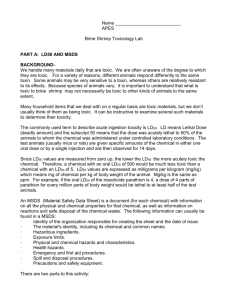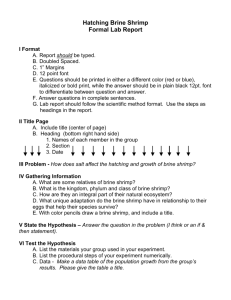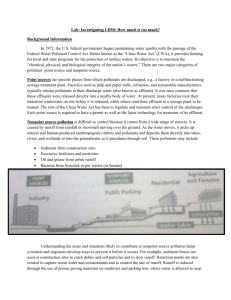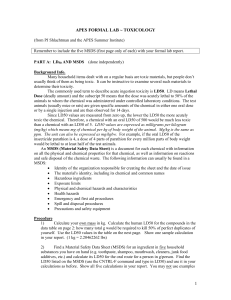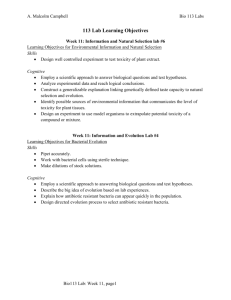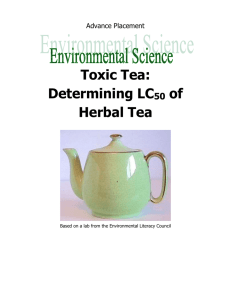Name Environmental Conservation Brine Shrimp Toxicology Lab
advertisement
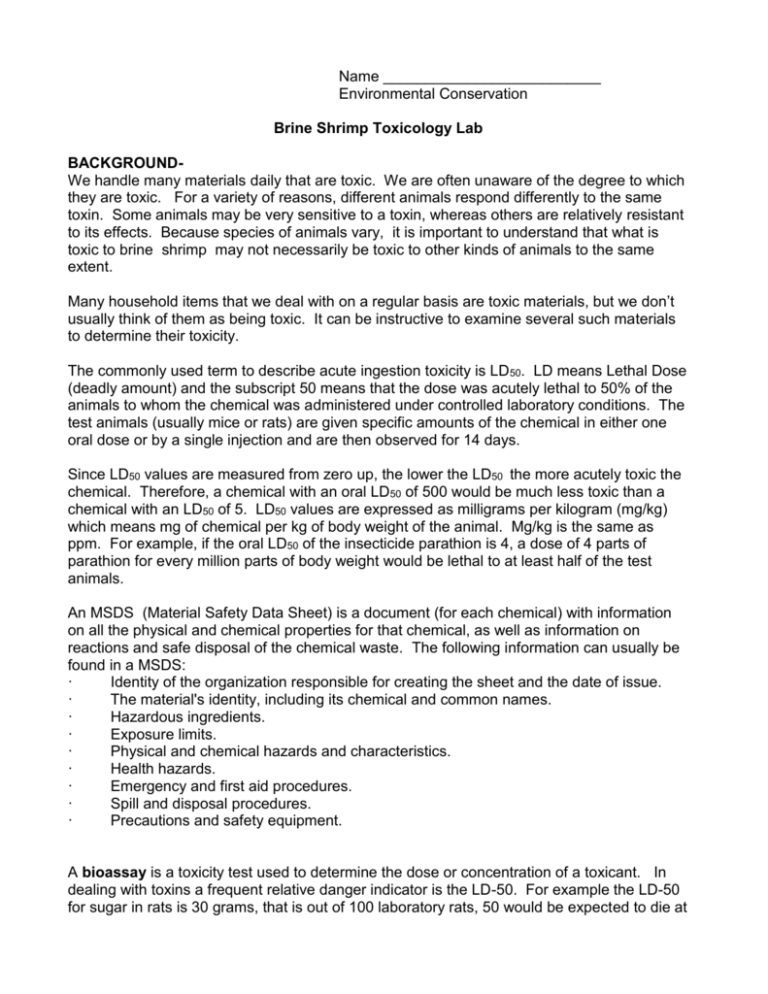
Name __________________________ Environmental Conservation Brine Shrimp Toxicology Lab BACKGROUNDWe handle many materials daily that are toxic. We are often unaware of the degree to which they are toxic. For a variety of reasons, different animals respond differently to the same toxin. Some animals may be very sensitive to a toxin, whereas others are relatively resistant to its effects. Because species of animals vary, it is important to understand that what is toxic to brine shrimp may not necessarily be toxic to other kinds of animals to the same extent. Many household items that we deal with on a regular basis are toxic materials, but we don’t usually think of them as being toxic. It can be instructive to examine several such materials to determine their toxicity. The commonly used term to describe acute ingestion toxicity is LD50. LD means Lethal Dose (deadly amount) and the subscript 50 means that the dose was acutely lethal to 50% of the animals to whom the chemical was administered under controlled laboratory conditions. The test animals (usually mice or rats) are given specific amounts of the chemical in either one oral dose or by a single injection and are then observed for 14 days. Since LD50 values are measured from zero up, the lower the LD50 the more acutely toxic the chemical. Therefore, a chemical with an oral LD50 of 500 would be much less toxic than a chemical with an LD50 of 5. LD50 values are expressed as milligrams per kilogram (mg/kg) which means mg of chemical per kg of body weight of the animal. Mg/kg is the same as ppm. For example, if the oral LD50 of the insecticide parathion is 4, a dose of 4 parts of parathion for every million parts of body weight would be lethal to at least half of the test animals. An MSDS (Material Safety Data Sheet) is a document (for each chemical) with information on all the physical and chemical properties for that chemical, as well as information on reactions and safe disposal of the chemical waste. The following information can usually be found in a MSDS: · Identity of the organization responsible for creating the sheet and the date of issue. · The material's identity, including its chemical and common names. · Hazardous ingredients. · Exposure limits. · Physical and chemical hazards and characteristics. · Health hazards. · Emergency and first aid procedures. · Spill and disposal procedures. · Precautions and safety equipment. A bioassay is a toxicity test used to determine the dose or concentration of a toxicant. In dealing with toxins a frequent relative danger indicator is the LD-50. For example the LD-50 for sugar in rats is 30 grams, that is out of 100 laboratory rats, 50 would be expected to die at levels of 30 grams of sugar/kg of body weight. Nicotine has an LD-50 in rats of 0.05 g, which is much more toxic. A similar measure, the LC-50, (which stands for lethal concentration) is often used. In this lab we will use a small crustacean, the brine shrimp. It is normally found in brackish water and is a very hearty little organism - able to tolerate high salt concentrations. MaterialsBrine Shrimp (purchased from aquarium store) Brine (specifically for Brine Shrimp, mixed with aquarium water) Household Ammonia Mouthwash Windex Garden Fungicide Dishwashing detergent (Dawn) Pine Sol or some other household disinfectant Pipettes (1 mL) Petri Dishes (6 per group) Dissecting Microscopes Test tube racks Permanent marker 6 Test tubes with caps Plastic gloves if handling toxic material Method- (work in groups of 2 or 3, at the most) 1) Label 5 test tubes as follows: 1:1, 1:10, 1:100, 1:1000, 1:10,000. Take 11 mL of the full-strength material being tested for toxicity from the stock solution and add it to the test tube labeled 1:1. Place 9 mL of brine into each of the other test tubes. Pipette 1 mL of "toxic" material from the 1:1 tube into the tube labeled 1:10. Mix well. 2) Pipette 1 mL from the 1:10 tube into the tube labeled 1:100. Mix well. This is 3) Pipette 1 mL from the 1:100 tube into the tube labeled 1:1000. Mix well called 4) Pipette 1 mL from the 1:1000 tube into the tube labeled 1:10,000. Mix well. “serial 5) Label 6 petri dishes as follows: 1:1, 1:10, 1:100, 1:1000, 1:10,000, control. Be sure to dilution” label the bottom of the dish, not the cover! Using a pipette, move 10 brine shrimp into each Petri dish. 6) Put 10 mL of brine in the control dish. Pour the contents of each tube into the appropriate Petri dish and observe for 10 minutes. Be sure to add the appropriate brine solutions as quickly as possible AFTER the brine shrimp are added to the Petri dish. 7) Using a dissecting microscope, count the number of brine shrimp alive after 10 minutes. Leave the shrimp in the dishes and determine how many are alive after 24 hours. Record your data in Data Table A. If you prefer concentration in percent versus “part per” (part per hundred, etc), the percents would be as follows: 1:1 = 100% (pollutant), 1:10 = 10%, 1:100 = 1%, 1:1000 = 0.1%, 1:10,000 = 0.01% Data Table A Material being tested dilution concentr ation # brine shrimp alive after 10 minutes # brine shrimp alive after 24 hours 1:1 100% 1:1 100% 1:10 10% 1:100 1% 1:1000 0.1% 1:10,000 0.01% 1:10 10% 1:100 1% 1:1000 0.1% 1:10,0000 0.01% AnalysisPlot a line graph of dilution (X axis) vs. survival #(Y axis) using Excel (directions are on the back of this page! Label the LD-50 and TTL on your graph. 1. What was/were the control(s) in this experiment? What is its purpose? 2. Based on your data in this lab, what is the last safe concentration for brine shrimp— Threshold Level of Toxicity (TTL)? 3. Often indicator species are used to study the overall health of an ecosystem. If you were to study an ecosystem containing brine shrimp, would you use it as an indicator species? Why or Why not? Explain your reasoning. 4. What possible sources of error were present in this experiment? How to make an LD 50 Line graph on Excel 1. Open excel 2. Set up the document to look like this and enter in your data: (you can use the percents in place of ratios if you prefer) % Concentration surviving 1:1 1:10 1:100 1:1000 1:10,000 control (you may need to format your cells to make them not convert the ratios to decimals. To do that, highlight the cells, then right click and select “format cells,” click the Numbers tab, the click on “text” Click OK) 3. Highlight the numbers area of your chart. 4. Click on the little picture of a graph (upper part of the screen) 5. Click on Line Graph 6. Click Next 7. A box will pop up – click on the “Series” tab 8. Delete what is in the “Values” box Now go onto your spreadsheet and highlight all the numbers under only the “% surviving” This formula should now appear automatically in the “values” area you just deleted. 9. Delete what is in the X axis labels box Now go onto your spreadsheet and highlight all the numbers under the “Concentration” area. This formula should now appear in the X axis labels box. 10. Change the “Title” to LD50 rate for (whatever you tested) 11. Type in the label for the x axis 12. Type in the label for the y axis 13. Click “next” 14. Click “Save as object in sheet 1” You can now copy and paste your graph into Word if you like!


